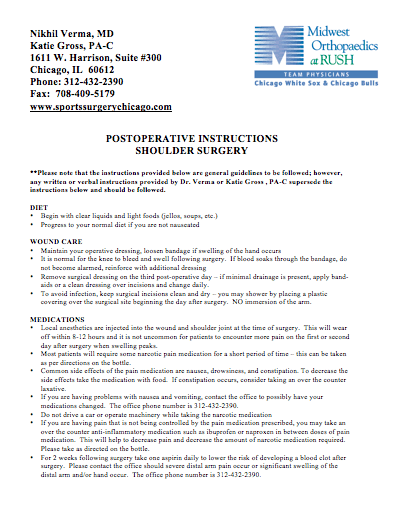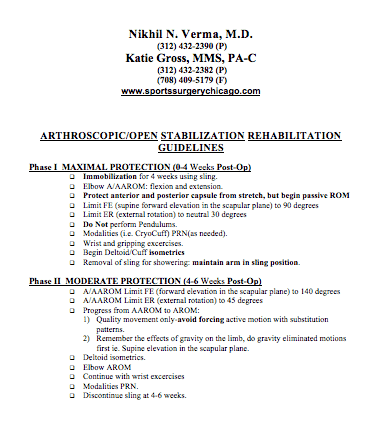Arthroscopic Stabilization for Shoulder Instability
Are you an athlete who participates in a sport that involve repetitive overhead motions? If so, you may be at risk of developing shoulder instability which requires surgical repair. Dr. Nikhil Verma provides diagnosis and arthroscopic stabilization surgery for patients in Chicago who are experiencing shoulder instability. Contact Dr.Verma’s team today!
Arthroscopic Stabilization for Shoulder Instability Overview
One of the most complex joints in the human body, the shoulder is formed by the humerus (upper arm bone) fitting in to the scapula (shoulder blade) in a ball and socket formation. A dislocated shoulder and anterior shoulder instability occurs when the humerus and scapula are pulled apart from a fall, sports injury or other trauma. In more severe “unstable” shoulder cases, a surgical procedure may be needed to repair ligament and joint surface damage and to reduce the risk of arthritis and re-dislocations. Dr. Nikhil Verma, shoulder surgeon treating patients living in the Chicago, Westchester, Oak Brook and Hinsdale, Illinois area, is highly experienced at performing arthroscopic stabilization for shoulder instability, a shoulder arthroscopy procedure.
A dislocated shoulder and anterior shoulder instability can be a painful condition for many patients. At the time of dislocation, the surrounding ligaments and cartilage can become damaged as well, including the rotator cuff, labrum, joint capsule or glenohumeral ligaments.
For any shoulder dislocation, no matter the severity, the initial treatment is to put the ball back into the socket, or reduce the shoulder. After the shoulder is reduced, Dr. Verma will perform a series of X-rays to look for any bone injuries and to confirm the shoulder joint is back in its original place. If the injury is severe, a surgical procedure may be recommended to provide full range of motion and stability back to the joint.
When surgery is needed, Dr. Verma will recommend arthroscopic stabilization for shoulder instability in many cases. Many patients who undergo this shoulder arthroscopy procedure for anterior shoulder instability have exceptional results following surgery and rehabilitation. They typically experience less pain, less complications and a quicker recovery time.
During the shoulder arthroscopy procedure, Dr. Verma will confirm the degree of anterior shoulder instability. He will then use a small camera and thin surgical instruments to inspect and repair the damaged areas. Suture anchors are used to reattach loose or torn ligaments to the glenoid bone. These sutures will restore the joint’s anatomy to its normal position and “tighten” the shoulder joint.
If a patient experiences bone loss, a dislocation that cannot be put back into place or long-standing anterior shoulder instability, open surgery may be recommended over shoulder arthroscopy.
Recovery and Rehabilitation after Arthroscopic Stabilization for Shoulder Instability
After anterior shoulder instability is corrected with shoulder arthroscopy, it is critical that the arm remains immobile in a sling for a certain period of time determined by Dr. Verma, typically three to six weeks. Pain medications and ice packs are recommended in many cases to help alleviate pain as the joint heals.
Patients are expected to begin their rehabilitation program following shoulder arthroscopy. Rehabilitation commonly consists of gentle passive range of motion followed by active motion, strengthening exercises and full return to activities. Patients will visit Dr. Verma and his team various times throughout recovery so he can assess the joint and therapy progression.
Post-Op Instructions for Shoulder Instability
Rehabilitation Guidelines for Shoulder Instability
For more information on shoulder dislocations and anterior shoulder instability, or to learn more about arthroscopic stabilization for shoulder instability, please contact the office of Dr. Nikhil Verma, Chicago, Westchester, Oak Brook and Hinsdale, Illinois area shoulder surgeon.




